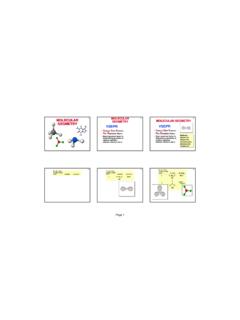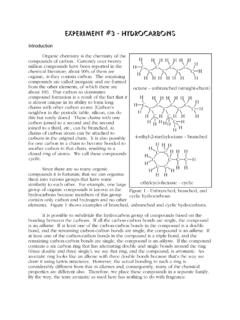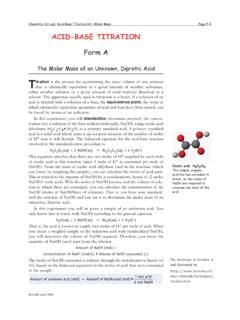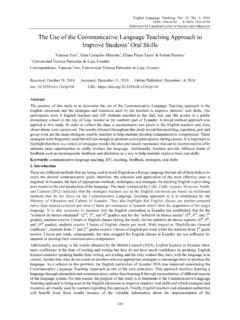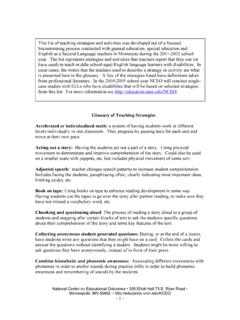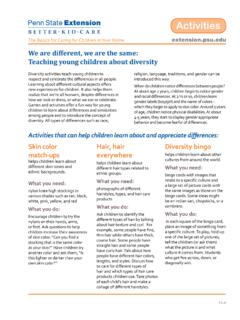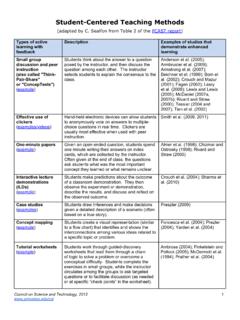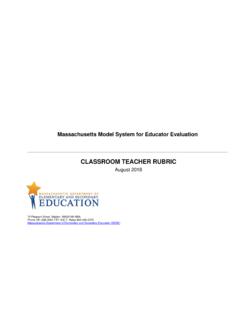Transcription of TEACHING TECHNIQUES - Oneonta
1 TEACHING TECHNIQUES93 TEACHING TECHNIQUESTell me,I me,I me,I Chinese Proverb94 TEACHING TECHNIQUESTHE NATURAL APPROACH IN THE CLASSROOMThe Natural Approach is designed to develop basic communication skills. The development stages are:(1) Comprehension (preproduction), (2) Early Production, and (3) Speech Emergence. This approach toteaching language has been proven to be particularly effective with limited English proficient ICOMPREHENSIONIn order to maximize opportunities for comprehension experiences. Natural Approach instructors (1)create activities designed to teach students to recognize the meaning in words used in meaningful contexts, and(2) teach students to guess at the meaning of phrases without knowing all of the words and structures of USE VISUAL AIDS (pictures, realia, gestures).
2 YOUR SPEECH to aid comprehension, speak more slowly, emphasize key words,simplify vocabulary and grammar, use related ideas , do not talk out of NOT FORCE PRODUCTION. Students will use English when they are ready. Theysometimes experience a silent period which can last days or ATTENTION ON KEY Activities in the Comprehension Physical Response (TPR). The teacher gives commands to which the students react withtheir bodies as well as their meaningful input based on items in the classroom or brought to class. (Who has the_____ ? Who is wearing a _____ ?) meaningful input based on Responses in the Comprehension action (TPR).
3 Name of a fellow student (from b., c. above). say yes/no in point to an item or do not initially make many attempts to communicate using words, rather they indicatetheir comprehension TECHNIQUESTHE NATURAL APPROACH IN THE CLASSROOMS tage 2 EARLY SPEECHIn non-threatening environments, students move voluntarily into Stage 2. Stage 2 begins when studentsbegin using English words to of word strings and short phrasesThe following are instructor question TECHNIQUES to encourage the transition from Stage I to Stage questions (Is Jimmy wearing a sweater today?) questions (Is this a pencil or an eraser?)
4 Which can be answered with a single word. (What does the woman have in her hand?Book. Where? When? Who?) questions which encourage lists of words. (What do we see on the table now?) sentence with pause for student response. (Mike is wearing a blue shirt, but Ron iswearing a _____ shirt.)During the Early Speech Stage, the instructor must give a meaningful and understandable input which willencourage the transition to Stage 3. Therefore all student responses should be expanded if possible. Here isa sample exchange between the teacher and the class:Instructor:What do we see in this picture?
5 :Yes, there is a woman in this picture. Is there a man? :Yes, there is. There is a man and a woman. Where is the man? :Yes that s right. The man is in a car. Is he driving the car? :Yes, he is. He s driving the sorts of activities which can be used in Early Speech , tables, ads96 TEACHING TECHNIQUESTHE NATURAL APPROACH IN THE CLASSROOMS tage 3 SPEECH EMERGENCE\In the Speech Emergence Stage, speech production will normally improve in both quatntity and sentences that the students produce become longer, more complex and tehy use a wider range ofvocabulary. Finally, the number of errors will slowly need to be given the opportunity to use oral and written language whenever possible.
6 Whenthey reach the stage in which speech is emerging beyond the two-word stage, there are many sorts of activitieswhich will foster more comprehension and speech. Some suggestions of all using charts, tables graphs, and (finger plays, flannel boards, puppets) , radio, television, film strips, exercises (especially Language Experience Approach) general, we may classify language acquisition activities as those in which the focus is on the message, , meaning. These may be of four (culture, subject matter, new information, reading) (student s own ideas , opinions, experiences) (focus on using language to participate in the game) (focus on using language to locate information)(From: Terrell, Department of Languages, University of California, San Diego)97 TEACHING TECHNIQUESS uggested Methods in TEACHING ThroughTotal Physical introduce and motivate the class you might.
7 "have a translator briefly explain the theory behind the method"show a documentary film of students learning through TPR, or"say commands rapidly in English and announce in the student s language that by the end of theclass everyone will understand everything that you just you begin each unit or lesson:"have a detailed outline or script of the elements that you will teach, the various combinations andrecombinations of elements, zany commands, and a strategy for varying from individuals to smalland large group movement."get props together and have them handy;"arrange the class so that there is a large space for the action and so that everyone can see(possibly a semi-circle).
8 I I Method (taken from TEACHING English Through Action ) - the students listen and respond to commands modeled by theinstructor.(1) Instructor commands and models with the entire group.(2) Instructor commands and models with 2-3 or 4-6 students.(3) Instructor commands and models with 1 responds to commands without of 3-5 students responds to commands without student responds to commands without recombines old and new commands and models with the group.(1) Group responds to recombined commands without instructor.(2) 2-3 students respond to recombined commands:- without instructor modeling- without TECHNIQUES2 Progression of Commands - The steps in the development of a unit look something actions ( walk , jump ) actions involving objects and locations ( walk to the door ) of actions and objects ( walk to the chair , touch the chair ) of actions and objects involving transferring meaning to a newsituation ( shake your head , shake my hand ) of actions leading into an activity sequence ( Take the can , Open thecan , Pour the water.)
9 Drink the lemonade ). clean responses to commands so that students will not pick upextraneous gestures that are false to the meaning of the command. (Forexample, don t swivel your head and then turn around with the command turn .) commands (new combinations of elements already mastered keepinterest high and enhance self-confidence as students realize they haveunderstood something never quite heard before.) new vocabulary 3 items at a time and proceed only after students areresponding students do not grasp a new item after a few trials, drop it until a future time.
10 (For example, students may not be able to transfer from point to the corner ofyour eye to walk to the corner of the room .) commanding individuals, call on confident students. Sometimes invitevolunteers by saying one student . A shy student may jump up and carry outa command because she or he was the first to understand varying who you call on by asking all the women, all the students on theright side, near the window, in row one, from Cuba. This keeps the studentsalert, never knowing who you will call on changing the order of the commands to increase listening Expressive Stage (Speaking) about 10 hours of TPR the students will begin to reveal a readiness to speak bymouthing or mumbling your commands out loud.

